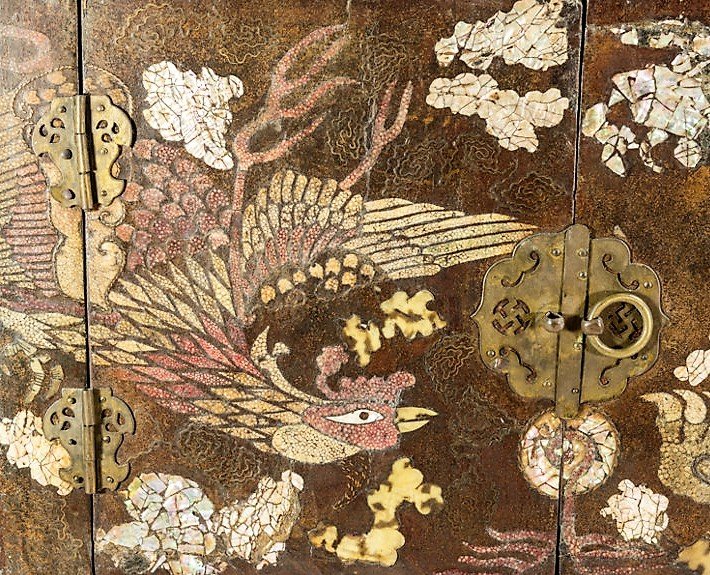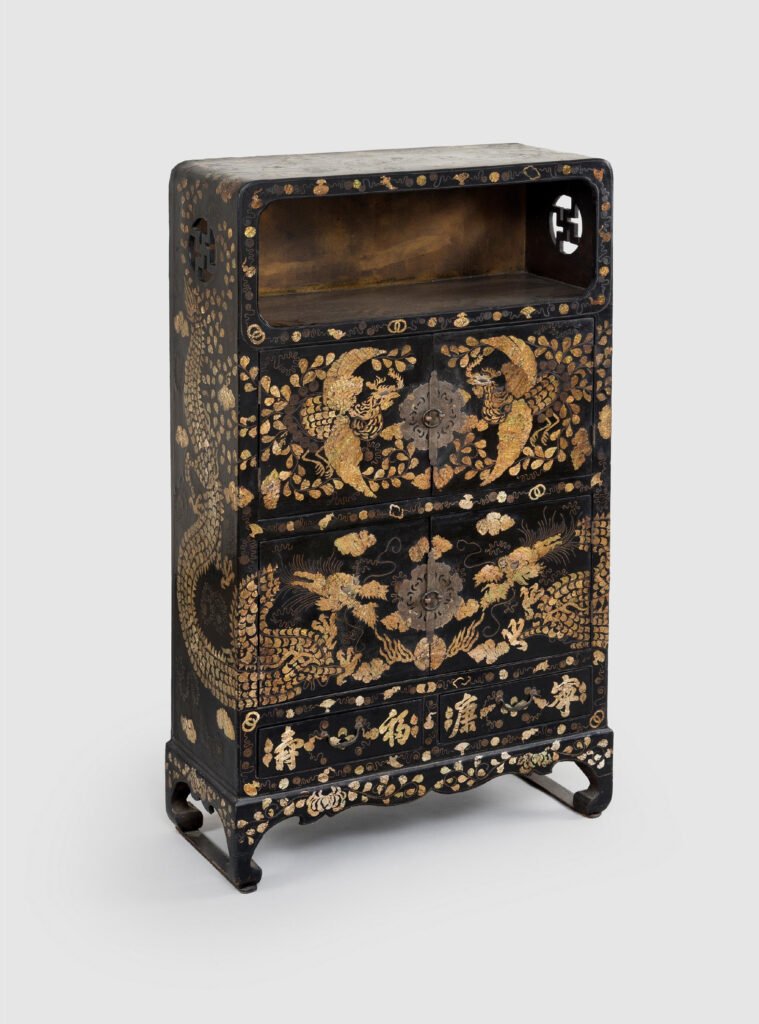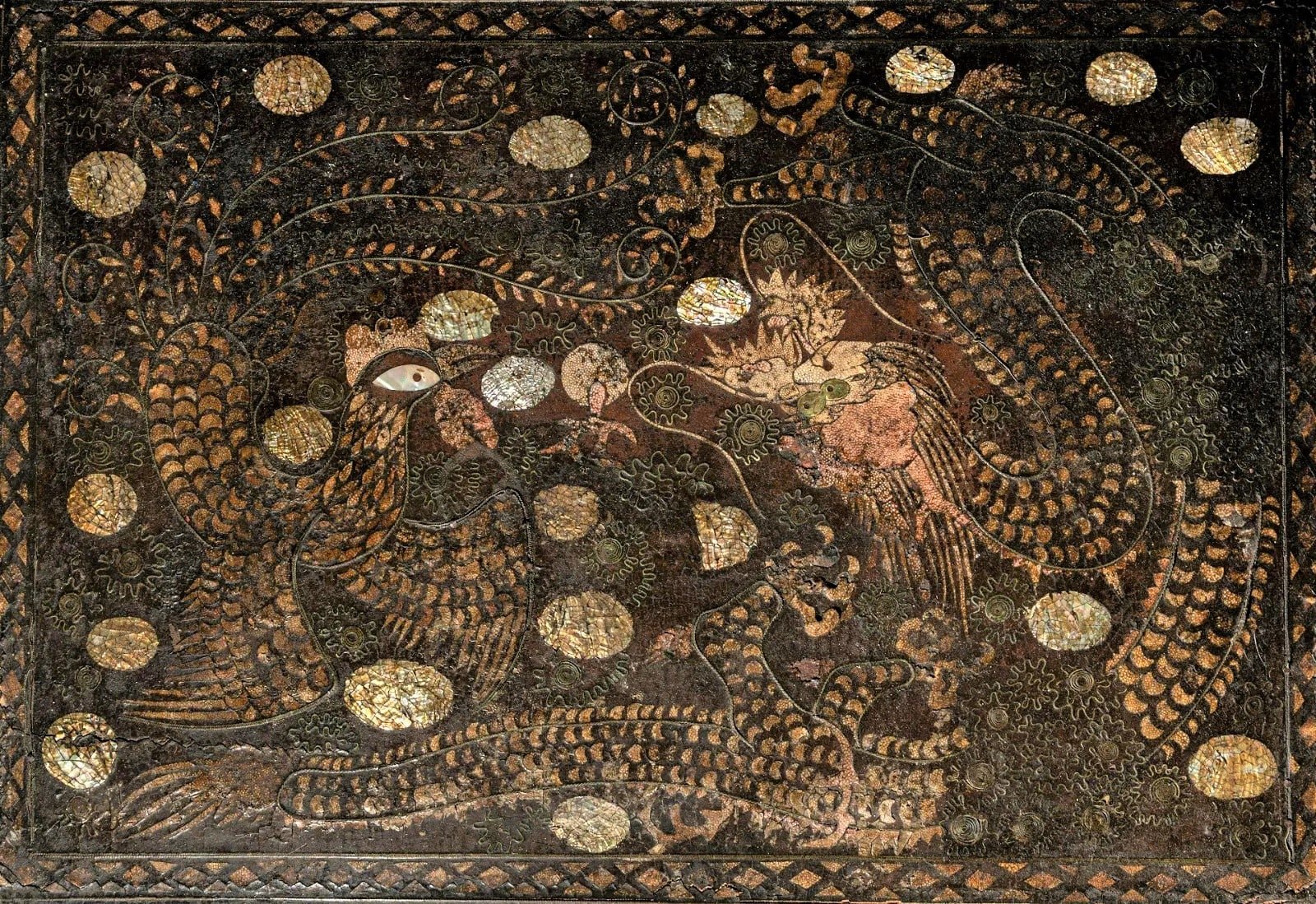These two emblems were borrowed from Chinese mythology and are occasionally found in Korean art.
Korean furniture is often adorned with auspicious motifs, frequently found on hinges or inlays made from materials such as mother of pearl, tortoiseshell, or shagreen.
This design is less commonly carved into wood, as is the case with Chinese furniture.

Lacquer on wood. H. 64,2cm, W. 35,5cm, D. 15,8cm.
A two-body, double-leafed, decorated with five-clawed dragons chasing pearls in the water, the uprights decorated with Greek friezes, the sides decorated with hexagonal cartouches with flowers on geometric background, the central fitting and the hinges in gilt bronze, the interior decorated with a pair of drawers.

Although less represented in Korean furniture, the dragon, known as “loong“, “long“, or “lung” in Chinese (龍), is a very important motif. It traditionally symbolizes potent and auspicious powers, particularly control over water, rainfall, typhoons, and floods.
The dragon is also a symbol of power, strength, and good luck for those deemed worthy of it in East Asian culture.
Historically, the Chinese dragon was associated with the Emperor of China and used as a symbol to represent imperial power.
The Phoenix, called Fenghuang (鳳凰) in Chinese and 봉황 in Korean, is a bird found in East Asian mythology that reigns over all other birds. In Chinese symbolism, it is a feminine entity that is paired with the masculine Chinese dragon, serving as a visual metaphor for a balanced and blissful relationship, symbolizing both a happy marriage and a regent’s long reign. The “Fenghuang” has positive connotations, symbolizing virtue and grace. It also represents the union of yin and yang.
“A dragon and a phoenix live on opposite sides of a magic river. One day they meet on an island and discover a shiny pebble. The dragon washes it and the phoenix polishes it until it becomes a pearl. Its brilliant light attracts the attention of the Queen of Heaven, and that night she sends a guard to steal it while the dragon and phoenix are sleeping. The next morning, the dragon and phoenix search everywhere and eventually see their pearl shining in the sky. They fly up to retrieve it, but the pearl falls down and becomes a lake on the ground below. The dragon and the phoenix lie down beside the lake, and are still there today in the guise of Dragon Mountain and Phoenix Mountain”.
The story is based on The Bright Pearl, a Chinese folk tale.


H. 91cm, W. 48cm.
Fine linen covered pine wood, and black lacquer was applied on it.
In the lower part of the front, a scene where two dragons fight over “Yeouiju” in a cloudy sky is arranged, and grass and insect patterns are decorated in a balanced way between them.
Other parts were decorated with grass and insect patterns on black lacquer with mother-of-pearl.
Given its elegance, it is presumed that this chest was used by the royal court.
Collection of the Gyeonggi Provincial Museum, Korea.
The dragon and the Phoenix in Korean art.
In Korea, as in China, the fictional dragon and the phoenix are traditional animals that symbolize auspiciousness. Along with the Qilin and the tortoise, they are collectively known as the “Four Supernatural Spirits.”
Individually, the Phoenix represents ‘yang’ energy (male energy), and when paired with the dragon, it symbolizes ‘yin’ energy (female energy). When both the dragon and phoenix come together, they symbolize love, harmony, and togetherness.
Therefore, the dragon, along with the phoenix, which is also considered the leader of all winged creatures, symbolizes marital bliss. When these two animals face each other, they convey the message of a happy reunion and a good omen. Most furniture decorated with such symbolism was intended for the woman’s quarters in a Korean house.


Clothing box decorated with dragons
19th century. Korea.
Lacquer inlaid with mother-of-pearl, tortoiseshell, and ray skin (Shagreen)
Metropolitan Museum (The Met), New York, USA.

In Korea, this pattern was often used on Ganghwa island where small boxes and furniture, intended for the royal family during the late Joseon Dynasty, were covered with a thick black lacquer inlaid with motifs using mother-of-pearl, shagreen and brass wire.

Two section lacquered chest on stand decorated with images of dragons and phoenix, inlaid with tortoiseshell, mother-of-pearl, and shagreen.
Late 19th, early 20th century.
H. 116,8cm, W. 79,3cm, D. 40 cm.

Paulownia wood covered with black lacquer inlay with shagreen, mother-of-pearl and brass wire. Late 19th century. This chest is typical of Ganghwa Island where furniture for royals were produced at the end of the Joseon dynasty. Private collection.








Collection National Folk Museum of Korea.

Collection: National Folk Museum of Korea.







Collection: National Museum of Korea.

Collection Kyungwoon Museum in Korea.











